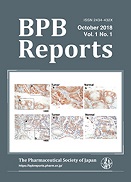Volume 3, Issue 4
Displaying 1-7 of 7 articles from this issue
- |<
- <
- 1
- >
- >|
Regular Article
-
2020 Volume 3 Issue 4 Pages 113-118
Published: 2020
Released on J-STAGE: November 26, 2020
Download PDF (1025K) Full view HTML
Regular Article
-
2020 Volume 3 Issue 4 Pages 119-125
Published: 2020
Released on J-STAGE: November 26, 2020
Download PDF (2177K) Full view HTML
Regular Article
-
2020 Volume 3 Issue 4 Pages 126-129
Published: 2020
Released on J-STAGE: November 26, 2020
Download PDF (1246K) Full view HTML
Regular Article
-
2020 Volume 3 Issue 4 Pages 130-137
Published: 2020
Released on J-STAGE: November 26, 2020
Download PDF (2531K) Full view HTML
Report
-
2020 Volume 3 Issue 4 Pages 138-141
Published: 2020
Released on J-STAGE: November 26, 2020
Download PDF (927K) Full view HTML
Regular Article
-
2020 Volume 3 Issue 4 Pages 142-145
Published: 2020
Released on J-STAGE: November 26, 2020
Download PDF (1386K) Full view HTML
Report
-
2020 Volume 3 Issue 4 Pages 146-149
Published: 2020
Released on J-STAGE: November 26, 2020
Download PDF (1149K) Full view HTML
- |<
- <
- 1
- >
- >|
